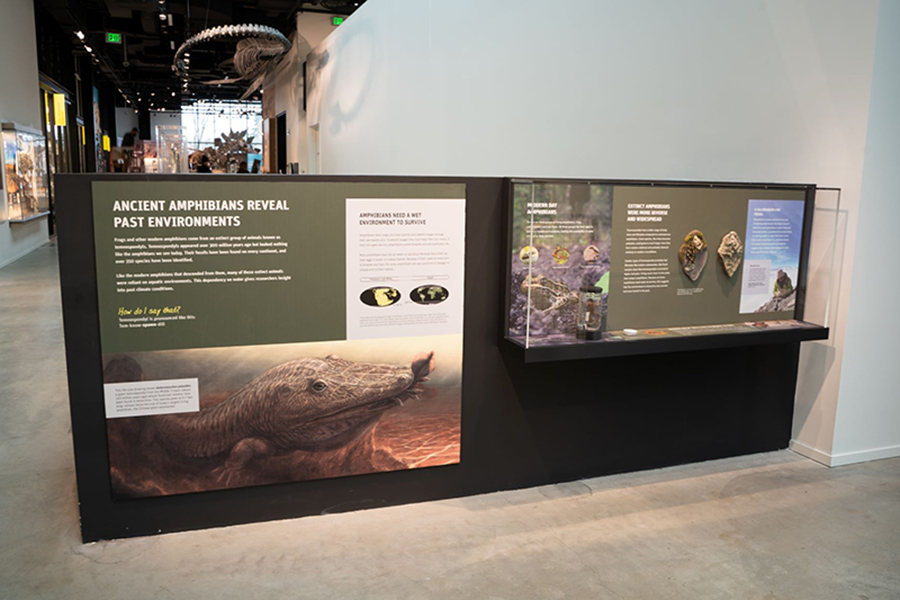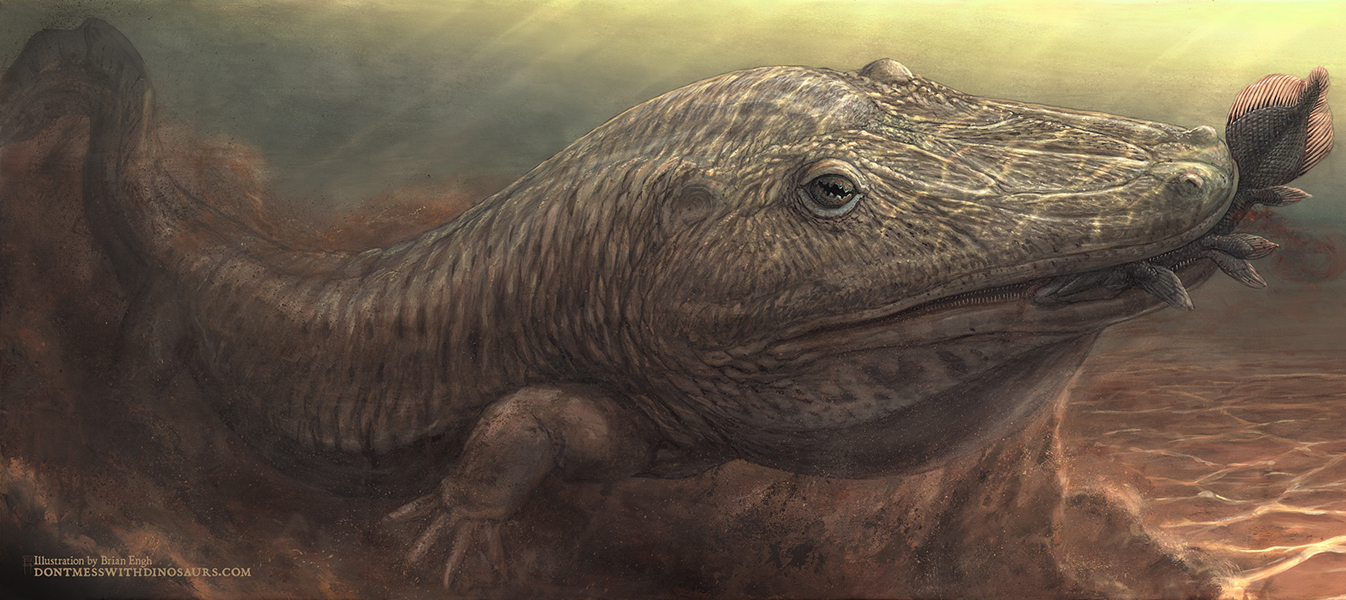Antarctic fossils shed new light on the lives of ancient amphibiansPaleontologists are piecing together a picture of life in the TriassicPosted March 21, 2022
Fossils of extinct amphibians found in Antarctica are helping paleontologists reconstruct how these ancient creatures once roamed the planet and understand how life evolved in the wake of Earth's largest mass extinction. During the 2017-2018 austral summer, scientists in Antarctica collected fossils of primitive amphibians known as temnospondyls from the Shackleton Glacier region of the Transantarctic Mountains. The fossils are about 250 million years old, meaning these ancient amphibians lived during the Early Triassic period. 
Photo Credit: Bryan Gee
An exhibit at the Burke Museum at the University of Washington displaying ancient amphibians.
Paleontologists Bryan Gee and Christian Sidor of the University of Washington recently published several studies analyzing the Shackleton Glacier fossils. The studies help scientists better understand the environment of the Early Triassic and have led to the reclassification of fossils collected in Antarctica more than 50 years ago. The new studies' results show that Earth's polar regions were likely a refuge for animals that survived the Permian-Triassic extinction 252 million years ago. Scientists call that extinction event ‘the Great Dying' because it's the most severe extinction event in Earth's history: more than 80 percent of ocean-dwelling species and 70 percent of land-dwelling vertebrates were wiped out. Moving poleward may have helped ancient amphibians survive the extinction event and thrive in the millennia it took for Earth's climate to cool back down, according to Gee and Sidor's work. “The Permian-Triassic transition was a really warm period in Earth's history, so being at high latitudes was advantageous for some animals that were effectively pushed away from the equator,” Sidor said. The fossils also help paleontologists understand what Antarctica's climate was like during this tumultuous period. Amphibians are sensitive to even small changes in climate and depend on water to reproduce, so their fossils indicate what regions of Earth were habitable and had fresh water in ages past. “The fact that there were amphibians living in Antarctica tells you that it was not covered in ice,” Gee said. A different kind of amphibianAmphibians first evolved around 370 million years ago, and today they include frogs, salamanders, and limbless worm-like creatures that live both on land and in water. Temnospondyls are ancestors of modern amphibians and make up an important link in the evolutionary chain. They were four-legged creatures that came in many sizes, from several inches to more than 20 feet long. Although they were amphibians, temnospondyls look nothing like today's frogs or salamanders. They were built more like reptiles and many had big, flat heads that resemble toilet seats. “These are totally different-looking animals,” Gee said. “If you saw a skeleton of one, you'd think it was a crocodile.” Temnospondyls were one of the few animal groups that survived the Permian-Triassic extinction. After the extinction event they flourished and diversified, having fewer species to compete with for food and fewer predators to avoid. “Temnospondyls are one of these groups that survived the mass extinction event, but they look radically different when they come out the other side,” Gee said. “The extinction is acting like a giant sieve, and a very select few creatures are going to be able to make it through.” Thriving in a new landscapeThe fossils recently collected from Shackleton Glacier were temnospondyls that lived shortly after the Permian-Triassic extinction. The exact cause of the extinction is unclear, but scientists suspect it was due to global warming from a massive volcanic eruption that lasted for over two million years. 
Photo Credit: Ghedoghedo, CC BY-SA 3.0, via Wikimedia Commons
A temnospondyl fossil skeleton on display at a museum in Germany.
Gee and Sidor are using the fossils to understand how life evolved in the millennia following the extinction. They've found that one of the newly collected fossils belongs to a species of small amphibian that has never before been documented in Antarctica. Their results show Antarctica's climate was warm and wet enough for amphibians to thrive during the Triassic and the continent may have been a refuge for species seeking cooler environments. At the time, all of Earth's land was fused together in the supercontinent Pangaea, so amphibians could have roamed more broadly, having no large oceans to cross. Antarctica was still in the Southern Hemisphere at the time, but it wasn't as far south as it is today. “If you think about modern amphibians, we know they're super climatically sensitive,” Gee said. “They do not occur in Antarctica or the Arctic Circle today, and typically not in deserts either. And they are really sensitive to the presence and quality of water. So the fact that in the Early Triassic they were distributed globally, it means a large swath of the world was habitable for them.” The results are helping scientists figure out how temnospondyls managed to thrive in the post-extinction landscape while so many other animals could not. “What were temnospondyls doing and was it different from what the rest of the fossil record tells us for that same time period?” Sidor said. “And the preliminary data shows that temnospondyls were doing something very different than what the rest of the animals were doing that were living on land.” A new look at old fossilsPaleontologists first collected temnospondyl fossils from Antarctica in the 1960s and 70s, but the fossils found were small bone fragments and it was difficult to assign them to a particular species. Gee and Sidor used the fossils collected in 2017 to reexamine those older fossils and better define their species. Researchers originally classified some of those 1970s fossils as a species found nowhere on Earth but Antarctica. They suspected one skull specimen belonged to an adult animal of a small species. But by looking at the preservation of the skull and the size of the eye sockets, Gee and Sidor now suspect the skull is that of a juvenile of a much larger amphibian species. “If I give you a small fossil specimen, how do you tell whether that's an adult of a small animal or a juvenile of a large animal? You cannot watch that animal grow up,” Gee said. “So that's one of the challenges for temnospondyls. We've been naming them thinking they're small animals when they're really just juveniles of some other much larger animal.” The results show how redefining one fossil changes how scientists think about a local environment. Lots of different types of amphibians coexist, both today and during the Triassic, so whether there's a concentration of small-bodied adults or small-bodied juveniles has different implications for that particular ecosystem, according to Gee and Sidor. Overall, the findings help clarify where on the globe different temnospondyl species lived, what environments they preferred, and how they survived the mass extinction. It's a puzzle that gets clearer with each new fossil discovered, and the Antarctic fossils are no exception. “One specimen can drastically change how you thought about local ecosystems or even globally how different clades are doing things,” Gee said. This research is supported by the National Science Foundation, which manages the U.S. Antarctic Program. NSF-funded research in this story: Christian Sidor, University of Washington, awards 1341304 and 1947094; and Peter Makovicky, Field Museum of Natural History, award 1341645. |
"News about the USAP, the Ice, and the People"



For USAP Participants |
For The Public |
For Researchers and EducatorsContact UsU.S. National Science FoundationOffice of Polar Programs Geosciences Directorate 2415 Eisenhower Avenue, Suite W7100 Alexandria, VA 22314 Sign up for the NSF Office of Polar Programs newsletter and events. Feedback Form |


